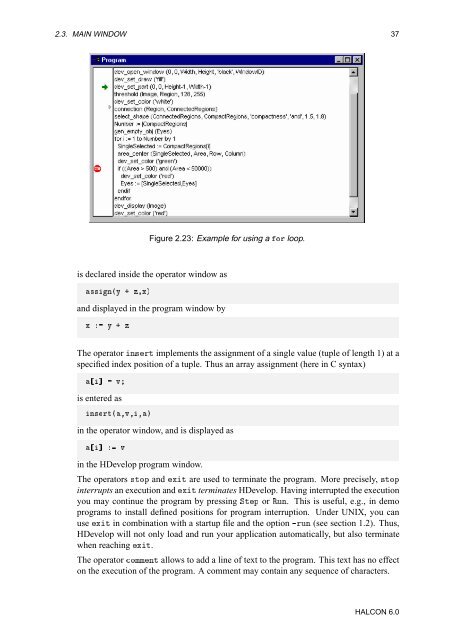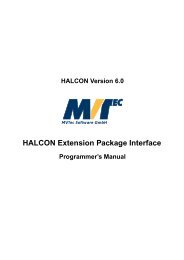Create successful ePaper yourself
Turn your PDF publications into a flip-book with our unique Google optimized e-Paper software.
2.3. MAIN WINDOW 37<br />
Figure 2.23: Example for using a ÓÖ loop.<br />
is declared inside the operator window as<br />
××Ò´Ý · ޸ܵ<br />
and displayed in the program window by<br />
Ü Ý · Þ<br />
The operator Ò×ÖØ implements the assignment of a single value (tuple of length 1) at a<br />
specified index position of a tuple. Thus an array assignment (here in C syntax)<br />
℄ Ú<br />
is entered as<br />
Ò×ÖØ´¸Ú¸¸µ<br />
in the operator window, and is displayed as<br />
℄ Ú<br />
in the <strong>HDevelop</strong> program window.<br />
The operators ×ØÓÔ and ÜØ are used to terminate the program. More precisely, ×ØÓÔ<br />
interrupts an execution and ÜØ terminates <strong>HDevelop</strong>. Having interrupted the execution<br />
you may continue the program by pressing ËØÔ or ÊÙÒ. This is useful, e.g., in demo<br />
programs to install defined positions for program interruption. Under UNIX, you can<br />
use ÜØ in combination with a startup file and the option ¹ÖÙÒ (see section 1.2). Thus,<br />
<strong>HDevelop</strong> will not only load and run your application automatically, but also terminate<br />
when reaching ÜØ.<br />
The operator ÓÑÑÒØ allows to add a line of text to the program. This text has no effect<br />
on the execution of the program. A comment may contain any sequence of characters.<br />
HALCON 6.0
















